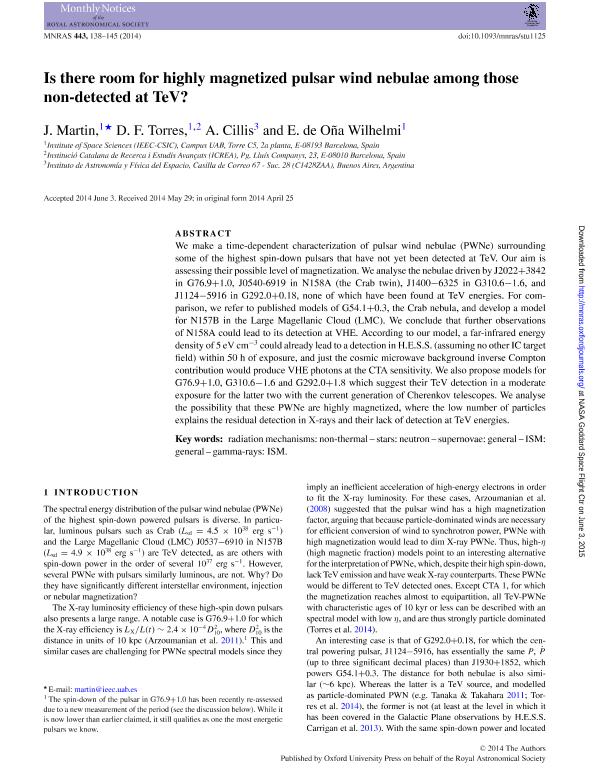Mostrar el registro sencillo del ítem
dc.contributor.author
Martín Rodriguez, Jonatan

dc.contributor.author
Torres, Diego F.

dc.contributor.author
Cillis, Analia Nilda

dc.contributor.author
Wilhelmi, Emma de Oña

dc.date.available
2017-05-15T18:50:27Z
dc.date.issued
2014-09
dc.identifier.citation
Martín Rodriguez, Jonatan; Torres, Diego F.; Cillis, Analia Nilda; Wilhelmi, Emma de Oña; Is there room for highly magnetized pulsar wind nebulae among those non-detected at TeV?; Oxford University Press; Monthly Notices Of The Royal Astronomical Society; 443; 1; 9-2014; 138-145
dc.identifier.issn
0035-8711
dc.identifier.uri
http://hdl.handle.net/11336/16501
dc.description.abstract
We make a time-dependent characterization of pulsar wind nebulae (PWNe) surrounding some of the highest spin-down pulsars that have not yet been detected at TeV. Our aim is assessing their possible level of magnetization. We analyse the nebulae driven by J2022+3842 in G76.9+1.0, J0540-6919 in N158A (the Crab twin), J1400-6325 in G310.6-1.6, and J1124-5916 in G292.0+0.18, none of which have been found at TeV energies. For comparison, we refer to published models of G54.1+0.3, the Crab nebula, and develop a model for N157B in the Large Magellanic Cloud (LMC). We conclude that further observations of N158A could lead to its detection at VHE. According to our model, a far-infrared energy density of 5 eV cm-3 could already lead to a detection in H.E.S.S. (assuming no other IC target field) within 50 h of exposure, and just the cosmic microwave background inverse Compton contribution would produce VHE photons at the CTA sensitivity. We also propose models for G76.9+1.0, G310.6-1.6 and G292.0+1.8 which suggest their TeV detection in a moderate exposure for the latter two with the current generation of Cherenkov telescopes. We analyse the possibility that these PWNe are highly magnetized, where the low number of particles explains the residual detection in X-rays and their lack of detection at TeV energies.
dc.format
application/pdf
dc.language.iso
eng
dc.publisher
Oxford University Press

dc.rights
info:eu-repo/semantics/openAccess
dc.rights.uri
https://creativecommons.org/licenses/by-nc-sa/2.5/ar/
dc.subject
Radiation Mechanisms: Non-Thermal
dc.subject
Stars: Neutron
dc.subject
Supernovae: General
dc.subject
Ism: General
dc.subject
Gamma-Rays: Ism
dc.subject.classification
Astronomía

dc.subject.classification
Ciencias Físicas

dc.subject.classification
CIENCIAS NATURALES Y EXACTAS

dc.title
Is there room for highly magnetized pulsar wind nebulae among those non-detected at TeV?
dc.type
info:eu-repo/semantics/article
dc.type
info:ar-repo/semantics/artículo
dc.type
info:eu-repo/semantics/publishedVersion
dc.date.updated
2017-05-02T20:13:24Z
dc.journal.volume
443
dc.journal.number
1
dc.journal.pagination
138-145
dc.journal.pais
Reino Unido

dc.journal.ciudad
Londres
dc.description.fil
Fil: Martín Rodriguez, Jonatan. Consejo Superior de Investigaciones Cientificas; España
dc.description.fil
Fil: Torres, Diego F.. Institució Catalana de Recerca I Estudis Avancats; España
dc.description.fil
Fil: Cillis, Analia Nilda. Consejo Nacional de Investigaciónes Científicas y Técnicas. Oficina de Coordinación Administrativa Ciudad Universitaria. Instituto de Astronomía y Física del Espacio. - Universidad de Buenos Aires. Facultad de Ciencias Exactas y Naturales. Instituto de Astronomía y Física del Espacio; Argentina
dc.description.fil
Fil: Wilhelmi, Emma de Oña. Consejo Superior de Investigaciones Cientificas; España
dc.journal.title
Monthly Notices Of The Royal Astronomical Society

dc.relation.alternativeid
info:eu-repo/semantics/altIdentifier/url/https://academic.oup.com/mnras/article-abstract/443/1/138/1475023/Is-there-room-for-highly-magnetized-pulsar-wind?redirectedFrom=fulltext
dc.relation.alternativeid
info:eu-repo/semantics/altIdentifier/doi/http://dx.doi.org/10.1093/mnras/stu1125
Archivos asociados
